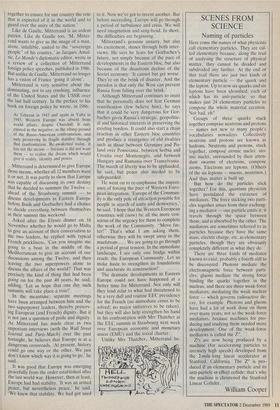SCENES FROM SCIENCE
Naming of particles
Here come the names of what physicists call elementary particles. They are cal- led elementary because, along the trail of analysing the structure of physical matter, they cannot be divided and subdivided any further. At the end of that trail there are just two kinds of elementary particle — the quark and the lepton. Up to now six quarks and six leptons have been identified, each of which has its anti-particle: so that makes just 24 elementary particles to compose the whole material creation. Not bad, eh?
Groups of three quarks stuck together comprise neutrons and protons — names not new to many people's vocabularies nowadays. Collectively neutrons and protons are known as hadrons. Neutrons and protons, stuck together, compose atomic nuclei: ato- mic nuclei, surrounded by their atten- dant swarms of electrons, compose atoms. Electrons are leptons. (Others of the six leptons — muons, neutrinos.) And thus matter is built up.
But how do the particles stick together? For this, quantum physicists have postulated the existence of mediators. The force sticking two parti- cles together arises from their exchang- ing a mediator — one particle emits it; it travels through the space between them; and is absorbed by the other. The mediators are sometimes referred to as particles because they have the same mass, electric charge, etc, as elementary particles, though they are obviously completely different in what they do.
There are three kinds of mediator known to exist, probably a fourth still to be discovered. Photons mediate the electromagnetic force between parti- cles; gluons mediate the strong force binding the quarks together in the nucleus; and there are three weak-force mediators, mediating the weak nuclear force — which governs radioactive de- cay, for example. Photons and gluons have had a lot of work done on them over many years; not so the weak-force mediators, because machines for pro- ducing and studying them needed more development. One of the weak-force mediators is called the Z°.
Z°s are now being produced by a machine (for accelerating particles to intensely high speeds) developed from the 2-mile-long linear accelerator at Stanford, California. The Z° is pro- duced if an elementary particle and its anti-particle in effect collide: that's why the machine is christened the Stanford Linear Collider.
William Cooper










































































 Previous page
Previous page